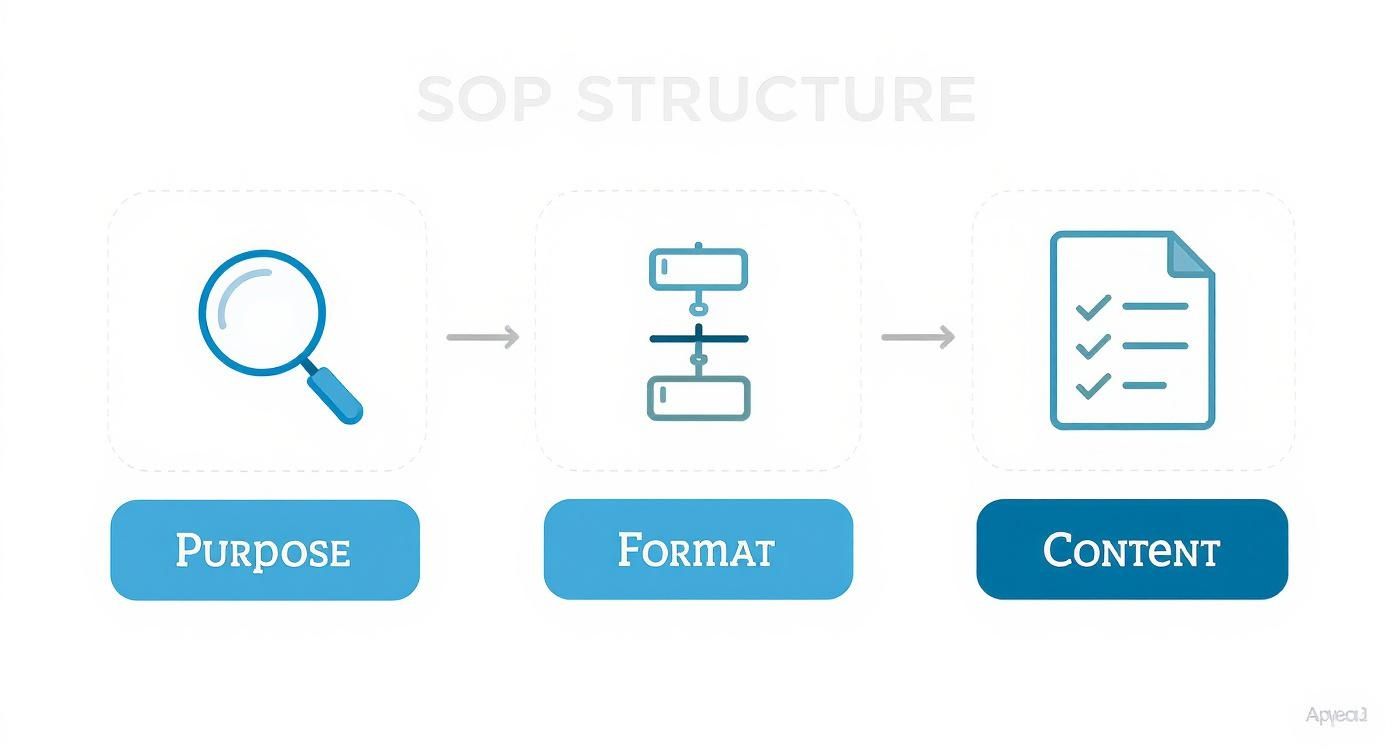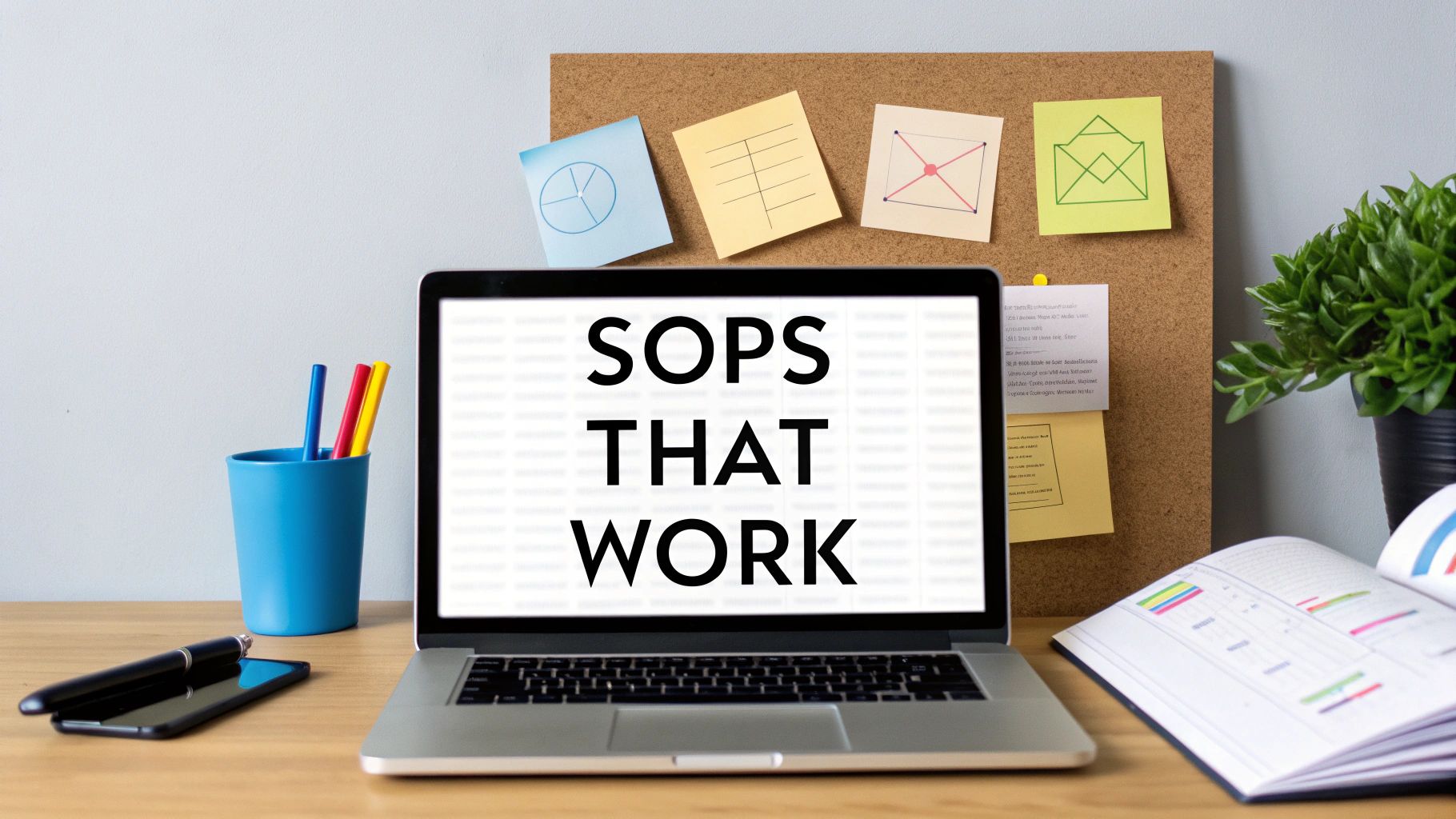How to Write Standard Operating Procedures That Work
Writing standard operating procedures isn't just about ticking a box. It's about building a clear, actionable playbook for every crucial task your business handles. This is how you nail consistency, slash errors, and get new hires up to speed in record time. You're essentially turning that "tribal knowledge" locked in your experts' heads into a powerful, scalable company asset.
Why Your Business Runs Better with Clear SOPs
Before we get into the nitty-gritty of how to write an SOP, let's talk about why they're a strategic game-changer, not just more paperwork. I've seen countless B2B and SaaS companies run on unwritten rules and "we've always done it this way" processes. That might work when you're a tiny team, but it creates a fragile system that shatters under the pressure of growth.
Think of clear SOPs as the backbone of a resilient, scalable operation. They become the single source of truth that transforms messy workflows into predictable, efficient systems.
From Ambiguity to Accountability
When procedures aren't written down, people are forced to guess. This inevitably leads to inconsistent results. You'll see one salesperson handling leads completely differently from another, or the support team using a dozen different ways to escalate a ticket. This isn't just inefficient; it’s a huge risk to your customer experience and reputation.
SOPs replace that guesswork with clarity. Everyone knows the standard, which means you can finally hold people accountable to it. They establish a performance baseline, making it incredibly easy to spot when a process is broken and figure out exactly why.
A well-crafted SOP doesn't stifle your top performers. It actually elevates the entire team to a higher standard, making excellence the default, not the exception.
This isn't just theory; there's real money behind it. The market for SOP management tools is on track to hit $4.0 billion by 2031. Why? Because companies that get this right see tangible results, like a 30% boost in process efficiency and a 25% drop in operational mistakes. You can dig into the data on the SOP management market to see just how big this trend is.
Protecting Your Most Valuable Asset
What's your company's most valuable asset? It's not your software or your client list. It's the institutional knowledge your team has built over time. When a key employee walks out the door, they take critical, undocumented expertise with them, leaving a knowledge vacuum that's both difficult and expensive to fill.
SOPs are your safeguard. They act as a central knowledge hub, protecting those vital workflows. This ensures the business keeps running smoothly during team changes and drastically cuts down the time it takes to onboard new hires.
Picture a new SaaS support agent confidently solving a complex customer ticket on their first day, all because they had a clear, step-by-step guide to follow. That's the real power of good documentation.
Ultimately, the time you invest upfront in writing SOPs pays off massively. You'll see the return in a few key areas:
- Reduced Training Time: New folks become productive team members way faster when they have a clear playbook.
- Enhanced Consistency: Every single client gets the same high-quality service, every single time.
- Improved Quality Control: Mistakes plummet because the right process is followed without fail.
- Greater Scalability: You can finally grow your business without the operational chaos that holds so many companies back.
Laying the Groundwork for an SOP That Actually Gets Used
Let’s be honest: a great standard operating procedure rarely starts with the first sentence. It begins with a bit of strategic thinking. If you just dive into writing, you’re basically trying to build a house without a blueprint. You might get a structure up, but it won’t be solid, and it certainly won’t be something your team wants to live in. This early stage is all about making sure you’re aiming your efforts at the right target.
Before you type a single word, you have to figure out which processes are worth documenting first. Not all workflows are created equal, right? A good place to start is by identifying the tasks that are either high-risk, happen all the time, or have a direct impact on your customers. A bug in your client billing process, for example, is way more critical to document than how to order snacks for the office.
How to Prioritize Your SOPs
Think of your company's operations as a big, interconnected web. Your job is to find the most critical junctions and document them first. A simple way I like to do this is by running each potential process through a quick filter.
- Risk and Impact: What’s the worst that could happen if this task is done incorrectly? If the answer involves a security breach, a major financial hit, or an angry client, it shoots to the top of the list.
- Frequency and Repetition: How often does this task get done? Documenting a process that happens ten times a day will give you a much better return on your time than something that only happens once a quarter.
- Complexity and Training: How tough is this for a new person to pick up? Complex, multi-step tasks are perfect for SOPs because they slash training time and stop you from relying on just one person who knows all the secrets.
Once you’ve got a shortlist, it’s time to define the scope for each one. An SOP that’s too broad becomes a huge, intimidating manual nobody will ever open. On the other hand, if it's too narrow, it won't give the reader the full picture. You’re looking for that sweet spot. For instance, instead of a vague "How to Manage Social Media," get specific with something like "How to Schedule and Publish a Post on LinkedIn."
Talk to the People Who Actually Do the Work
Here’s the most important piece of advice I can give you for writing an SOP people will use: go talk to the employees who live and breathe this process every single day. A manager’s view from 10,000 feet often misses the clever workarounds, the common snags, and the little details that make up the real workflow. If you ignore your frontline team's knowledge, you’re on the fast track to creating a document that’s technically correct but completely useless in practice.
And gathering that knowledge means doing more than just a quick hallway chat.
- Do one-on-one interviews: Sit down with the person who knows the process inside and out. Have them walk you through it, but make sure to ask why they do things a certain way, not just what they do.
- Watch the process in action: Words don't always tell the whole story. Shadow them as they do the task. You’ll be amazed at the small but critical steps you'll pick up that would never come up in conversation.
This isn’t just about getting the facts right. When your team contributes to the document, they feel a sense of ownership. That feeling makes them far more likely to actually use it and encourage others to do the same.
Involving your team isn’t just a nice-to-have; it's a non-negotiable. An SOP written in a vacuum is destined to collect digital dust on a server somewhere.
If you’re just getting your feet wet with this, you might find a guide to creating your first SOP helpful for a solid overview. And for those looking to get a head start, checking out some business process documentation templates can give you a solid framework so you’re not starting from scratch. Putting in this prep work ensures your final SOP is a reflection of reality, not just theory.
Building an SOP That Your Team Will Actually Use
You’ve done the hard work of mapping out a process. Now comes the critical part: turning that knowledge into a document that people will actually follow. The way you structure your standard operating procedure is just as important as the information inside. A sloppy, confusing SOP gets ignored. A clean, well-organized one becomes a trusted resource.
The goal here isn't to write a dense, corporate manual that collects dust. You're building a practical guide that someone can pull up and scan in the middle of a task. That means we need to prioritize clarity, use simple language, and pick a format that makes sense for the job at hand.
The Anatomy of a High-Impact SOP
Every great SOP, whether it’s a simple checklist or a detailed flowchart, is built on the same foundation. Think of these as the non-negotiable elements that give your team the context they need to execute a task correctly. If you skip them, you're paving the way for confusion.
Here are the absolute must-haves for every SOP you create:
- A Crystal-Clear Title: Get specific. "Customer Onboarding" is vague. Try "How to Set Up a New B2B Client Account in Salesforce" instead. A precise title means your team can find the right document in seconds.
- Purpose Statement: This is the "why." In one or two sentences, explain the reason this process exists. For example: "This procedure ensures all new client accounts are created consistently, which prevents data errors and guarantees a smooth handoff to the support team."
- Scope: Be upfront about what this SOP covers and, just as importantly, what it doesn't. This stops people from applying a procedure to the wrong situation. For instance: "This SOP applies to standard B2B client accounts. It does not cover Enterprise-level or partner accounts."
- Roles and Responsibilities: Spell out exactly who does what. Assigning tasks to specific roles (e.g., "Account Manager," "Onboarding Specialist") removes any guesswork about ownership.
Getting these foundational pieces right is a huge part of learning how to document business processes in a way that truly helps your team. They provide the necessary context before anyone even gets to the first step.
Choosing the Right Format for the Job
Not all workflows are the same, so your SOP formats shouldn’t be a one-size-fits-all solution. The way you present the information can be the difference between a procedure that gets followed religiously and one that’s forgotten immediately. The secret is matching the format to the complexity of the task.
- Simple Checklists: These are your best friend for routine, linear tasks where nothing should be missed. Think of a daily social media posting checklist or an end-of-day office shutdown procedure. The satisfaction of ticking a box provides a clear sense of completion.
- Hierarchical Outlines: When you’re dealing with more complex processes that have distinct phases, this is the way to go. It breaks down major stages into smaller, more manageable sub-steps. A perfect example is a procedure for "Publishing a New Blog Post," with main steps like Drafting, Editing, and Promotion, each with its own list of tasks.
- Visual Flowcharts: Got a process with decision points? Where someone has to decide "if this happens, do that"? A flowchart is your answer. It visually maps out the different paths, making it incredibly easy for users to navigate conditional logic. This is ideal for things like troubleshooting guides or customer support escalation paths.
The best format is always the one that makes the process easiest for the end-user to understand at a glance. Don't be afraid to mix and match; a hierarchical SOP might include a small flowchart to explain a single, complex decision point.
Write for Clarity, Not Complexity
Your choice of words is everything. Ditch the corporate jargon, overly formal language, and technical acronyms that a new hire would have to Google. Your goal is to communicate, not to sound like a business textbook.
Keep it simple and direct:
- Use Active Voice: Instead of "The report should be submitted by the manager," write "The manager submits the report." It’s cleaner and more direct.
- Keep Sentences Short: Long, winding sentences are a chore to read. If you have a complex idea, break it down into a few shorter, simpler sentences.
- Embrace Visuals: For any process that happens on a screen, screenshots are non-negotiable. Use arrows, circles, and callouts to show people exactly where to click. Diagrams and even short video clips can also be a massive help for more hands-on tasks.
This isn’t just good advice; it's backed by results. Clear, easy-to-use documentation drives adoption and cuts down on mistakes. In fact, surveys show that over 60% of organizations using dedicated SOP software report better compliance and fewer operational risks. It's a testament to how effective digital procedures can be when they’re easy to find and understand. You can dig into more details on SOP software market trends to see the full impact.
To bring it all together, here’s a quick rundown of the essential components every robust SOP should include. Use this as a checklist to structure your documents for maximum clarity and impact.
Essential Components of a Standard Operating Procedure
| Component | Purpose | Best Practice Example |
|---|---|---|
| Title | To clearly identify the SOP's subject matter instantly. | "How to Process a Client Refund in Stripe" |
| Purpose Statement | To explain the "why" behind the procedure in 1-2 sentences. | "To ensure all refunds are processed accurately and consistently, maintaining financial records and customer satisfaction." |
| Scope | To define the boundaries of the procedure and when it applies. | "This procedure applies to full and partial refunds for SaaS subscriptions. It does not cover hardware returns." |
| Responsibilities | To assign clear ownership of the tasks within the SOP. | "Sales Operations is responsible for initiating the refund. The Finance Team is responsible for final approval." |
| Procedure Steps | To provide clear, actionable instructions for completing the task. | "1. Open the client's profile in Stripe. 2. Click the 'Refund Payment' button. 3. Enter the refund amount and reason." |
| Visual Aids | To clarify complex steps and guide the user through interfaces. | Include a screenshot of the Stripe interface with an arrow pointing to the "Refund Payment" button. |
| Review Information | To maintain document relevance and track changes. | "Last Reviewed: [Date] by [Name]. Next Review Date: [Date]." |
Think of this table as your blueprint. By consistently including these elements, you'll create SOPs that are not only comprehensive but also genuinely helpful for your team.
Getting Your New SOPs Off the Ground and Into Practice
You've done the hard work of creating a clear, well-structured standard operating procedure. That’s a huge win, but it’s really only half the battle. An SOP that just sits in a shared drive is nothing more than a document. Its real value comes alive when your team actually starts using it.
Success isn't about just blasting out a PDF in an email and hoping for the best. It requires a thoughtful rollout that turns your documented process into a team-wide habit. Getting from a final draft to a fully adopted procedure involves some crucial review, approval, and training. This is where you iron out the wrinkles, get true buy-in, and make sure the new process genuinely makes everyone's job easier. A rushed launch can cause more headaches than it solves.
It All Starts with a Multi-Stage Review
Before any SOP goes live, it needs to be pressure-tested by the people who will actually be in the trenches using it. A multi-stage review is your best defense against creating something that looks great on paper but falls apart in practice. This isn't about seeking endless approvals; it's about collaborative refinement.
First up, get a peer review. Share the draft with a couple of teammates who perform the task day in and day out. They are your on-the-ground experts who will instantly spot a missing step, awkward phrasing, or an instruction that just isn't practical. Their feedback is pure gold.
Next, it's time for a manager or team lead to take a look. They’ll be viewing the process from a higher altitude, checking for alignment with department goals, resource needs, and overall efficiency. This is often when potential bottlenecks or impacts on other departments get flagged.
Finally, loop in any key stakeholders if the process touches other teams. For instance, if you're drafting an SOP for client invoicing, you absolutely need both the project management and finance teams to give it their blessing.
An SOP is a team agreement, not a top-down directive. The review process is your chance to build that consensus and make sure everyone is on board before you officially launch.
This infographic breaks down the core structure that makes a great SOP tick, from nailing its purpose to finalizing the content.

When you follow a logical flow from purpose to format to content, you end up with a document that’s clear and a breeze for anyone to follow.
Go Beyond the PDF: Train Your Team for Success
Just sharing the final document is a recipe for failure. Real, effective training is what bridges the gap between knowing a new process exists and being able to execute it flawlessly. The goal here is to make the new procedure feel like a natural, intuitive part of the daily grind.
Don’t just rely on a single email announcement. Think about using a mix of training methods to really make it stick:
- Live Walkthroughs: For more complex processes, get the team together for a live demo. Walk them through the SOP step-by-step, either in person or on a video call, so they can ask questions in the moment.
- Quick Video Tutorials: Record a short screencast that shows the process in action. This is perfect for software-based workflows and becomes an amazing resource people can go back to whenever they need a quick refresher.
- Hands-On Practice: Let the team try the new process in a safe, controlled environment. If you're rolling out a new CRM data entry SOP, use a sandbox or training database so they can practice without messing with live client data.
Navigating the Inevitable Resistance to Change
Even the most brilliantly designed process will probably face some pushback. People are creatures of habit, and change—even good change—can feel disruptive. Winning your team over isn't about enforcing a new rule; it’s about showing them the value. You have to answer their unspoken question: "What's in it for me?"
Frame the new SOP around the direct benefits to them. Does it get rid of a tedious manual task? Does it cut down on errors that lead to frustrating rework? Highlighting how the new procedure makes their job easier, not just more standardized, is how you get them on your side.
This isn't a new problem. One study found that 54% of frontliners in a multinational company struggled with new standards. It just goes to show how tough it can be to get everyone on the same page when old habits are strong.
Let’s look at a real-world example. Imagine a digital agency introducing a new SOP for invoicing clients.
- The Problem: Invoicing was a mess. Project managers used different templates, forgot to include important details, and often sent invoices late. This was creating cash flow issues and a lot of friction with the finance team.
- The SOP: A new, standardized invoicing process was built right into their project management tool. It included a clear checklist, a pre-built template, and automated reminders.
- The Rollout: Instead of just sending an email, the operations director held a 30-minute training session. Crucially, he didn't just show them how to do it. He showed them how it would save each of them at least an hour a month and kill all those stressful back-and-forth emails with finance.
By zeroing in on the personal benefit—saving time and reducing stress—he got enthusiastic buy-in. Successfully navigating this human element is a core part of any major process shift, which is why it's so critical to implement change management with a clear, empathetic strategy.
Keeping Your SOPs Relevant and Up to Date
Getting that first draft of an SOP done feels great, but the work isn't over. Honestly, an outdated standard operating procedure can be more dangerous than having none at all. It just creates confusion, lets bad habits creep in, and can cause real problems when people are following instructions for a process that doesn't even exist anymore.
The real secret to making SOPs work long-term is to treat them as living documents. Your business changes, you get new tools, and your team finds better ways of doing things. For your SOPs to stay useful, they have to change right along with the business.
Establish a Regular Review Cadence
The quickest way for your SOPs to become useless is to have no formal process for checking on them. We've all heard it: "We'll update it when something changes." In reality, that almost never happens. People get swamped, small tweaks go undocumented, and pretty soon you have a huge gap between what the SOP says and what people are actually doing.
It’s much better to get ahead of the problem. You need to set a non-negotiable schedule for reviewing every single SOP your team relies on.
- High-Impact Procedures: For your most critical or frequently used SOPs—the ones that could really cause trouble if they're wrong—a quarterly review is a good idea. This keeps your most important workflows perfectly in sync with reality.
- Standard Procedures: For most other SOPs, a simple annual review is a solid baseline. It's often enough to catch any process drift before it becomes a major issue.
Don't let reviews become a chore. I like to frame them as a chance for continuous improvement. It’s the perfect time for the team to step back and ask, "Is there a better, faster, or safer way we could be doing this?"
The key to making this system stick is assigning a specific owner to each SOP. This person is on the hook for leading the review, gathering feedback, and making sure the updates get done. That single point of accountability is what prevents things from falling through the cracks.
Create a Clear Path for Updates
Your review schedule is a great safety net, but what about the changes that pop up in between? Your team on the front lines will always be the first to spot when an SOP doesn't match what’s happening day-to-day. You have to give them a dead-simple way to flag issues and suggest improvements.
This doesn't need to be fancy. A dedicated Slack channel (#sop-updates), a simple form, or allowing comments on the document itself can work perfectly. The main thing is that everyone knows the process and feels comfortable speaking up.
Use the Right Tools to Track Changes
This is where so many teams drop the ball. Trying to manage versions with email attachments and file names like Client_Onboarding_SOP_FINAL_v2_new_updated.docx is a guaranteed path to chaos.
Fortunately, modern tools make this much easier to handle.
| Tool Type | How It Helps with SOP Updates |
|---|---|
| Dedicated SOP Software | Most have built-in version control, approval flows, and audit trails. Everyone automatically sees the latest version, no questions asked. |
| Project Management Tools | You can create a recurring task for each SOP review, assign it to the owner, and track the update from start to finish. |
| Simple Cloud Documents | Even tools like Google Docs or Notion have a version history, letting you see who changed what and when. |
The specific tool you use matters less than the principle behind it: maintain a single source of truth. When your team knows exactly where to find the most current version of any procedure, you get rid of the guesswork and ensure everyone is playing from the same sheet of music.
Common SOP Writing Questions Answered
Even with the best template in hand, you're bound to run into a few tricky questions when you start writing your SOPs. Let's tackle some of the most common ones I hear from teams all the time.
What’s the Ideal Length for an SOP?
This is the big one, and the honest answer is: it depends. An SOP should be as long as it needs to be to get the job done right, but not a single word longer.
There’s no magic number. A daily task, like prepping the sales CRM for the day, might just be a one-page checklist. But a complex process, such as onboarding a new enterprise client, could easily run several pages. The real focus should always be on usability, not length.
If you find your SOP is becoming a monster document, that's a huge red flag. It usually means the process you're trying to document is too big. The best solution? Break it down into a series of smaller, more manageable SOPs that cover each major phase.
How Do I Pick the Right Format?
The task itself will tell you which format to use. Don't try to cram a multi-faceted process into a simple checklist just because it looks cleaner—that's a recipe for confusion. The goal is to match the format to the workflow's logic so anyone can follow it.
Here’s a quick guide based on what I’ve seen work best:
- Simple Checklists: These are perfect for straightforward, linear tasks where you can't miss a step. Think of a checklist for publishing a new blog post.
- Hierarchical Outlines: When you have a complex process with distinct stages, this format is your friend. A great example is a software deployment SOP, where major steps have detailed sub-steps.
- Flowcharts: For any process that has decision points ("if X happens, do Y"), nothing beats a flowchart. They create a visual map of every possible path, which makes them ideal for things like customer support troubleshooting.
The biggest mistake you can make when writing SOPs is creating them in a vacuum. Always involve the people who perform the task daily. They know the reality of the workflow, and their input is what makes a document practical instead of theoretical.
How Often Should SOPs Be Reviewed?
SOPs are living documents, not museum artifacts. They need regular check-ups to stay useful.
A good rule of thumb is an annual review for most of your standard procedures. But for anything high-stakes or business-critical, like financial reporting or data security protocols, a quarterly review is a much smarter move.
Beyond a fixed schedule, the real golden rule is this: update an SOP immediately after any system, tool, or policy changes. Don't wait for the formal review date. To make this happen, you need a culture where anyone on the team feels empowered to point out something that's outdated. Assigning a clear "owner" to each SOP is the best way to keep them current and ensure someone is accountable.
At MakeAutomation, we specialize in turning complex operations into clear, repeatable systems. If you're ready to build a foundation of powerful SOPs that drive consistency and growth, we can help you create and implement the exact frameworks your business needs. Learn how we can optimize your processes today.







